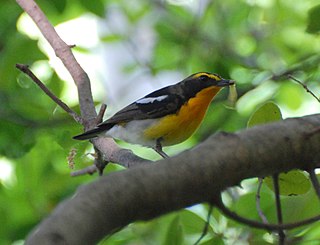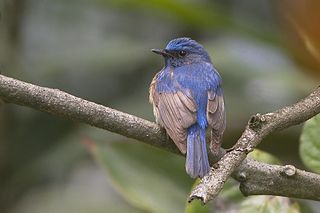
The Siberian rubythroat is a small passerine bird first described by Peter Simon Pallas in 1776. It was formerly classed as a member of the thrush family, Turdidae, but is now more generally considered to be an Old World flycatcher of the family Muscicapidae. The Siberian rubythroat and similar small European species are often called chats.

The bluethroat is a small passerine bird that was formerly classed as a member of the thrush family Turdidae, but is now known to be an Old World flycatcher, in the family Muscicapidae. It, and similar small European species, are often called chats.

Temminck's stint is a small wader. This bird's common name and Latin binomial commemorate the Dutch naturalist Coenraad Jacob Temminck. The genus name is from Ancient Greek kalidris or skalidris, a term used by Aristotle for some grey-coloured waterside birds.

The collared flycatcher is a small passerine bird in the Old World flycatcher family, one of the four species of Western Palearctic black-and-white flycatchers. It breeds in southeast Europe and Eastern France to the Balkan Peninsula and Ukraine and is migratory, wintering in sub Sahara Africa. It is a rare vagrant in western Europe.

The red-breasted flycatcher is a small passerine bird in the Old World flycatcher family. It breeds in eastern Europe and across Central Asia and is migratory, wintering in south Asia. The bird is a regular passage migrant in western Europe, whereas the collared flycatcher which breeds further east is rare. This is because of the different migration direction. The Asian species Ficedula albicilla, previously considered a subspecies of the red-breasted flycatcher, has the red throat surrounded by grey and a different song. It is usually now separated as the taiga flycatcher.

The white-throated robin, or irania, is a small, sexually dimorphic, migratory passerine bird. The vernacular and genus name Irania alludes to Iran, its type locality, while the specific name gutturalis is Medieval Latin for "of the throat". It breeds in western Asia and overwinters in East Africa.

The Asian brown flycatcher is a small passerine bird in the flycatcher family Muscicapidae. The word Muscicapa comes from the Latin musca, a fly and capere, to catch. The specific dauurica refers to Dauria, an area of south-eastern Siberia named after a local nomadic tribe.

The Kashmir flycatcher is a small passerine bird in the flycatcher family Muscicapidae. It breeds in the Northwest Himalayas and winters in southern India and Sri Lanka. It was formerly considered to be a subspecies of the red-breasted flycatcher, Ficedula parva, which is its closest living relative. Males are distinctive in having a blackish border to the reddish throat while the females can easily be confused with those of F. parva.

Tickell's blue flycatcher is a small passerine bird in the flycatcher family. This is an insectivorous species which breeds in tropical Asia, from the Indian Subcontinent eastwards to Bangladesh and western Myanmar. The Indochinese blue flycatcher was formerly considered conspecific. They are blue on the upperparts and the throat and breast are rufous. They are found in dense scrub to forest habitats. The name commemorates the wife of the British ornithologist Samuel Tickell who collected in India and Burma.

The Indian paradise flycatcher is a medium-sized passerine bird native to Asia, where it is widely distributed. As the global population is considered stable, it has been listed as Least Concern on the IUCN Red List since 2004. It is native to the Indian subcontinent, Central Asia and Myanmar.

The rufous-tailed robin is a small passerine bird. Its breeding range extends from southern Siberia and the Sea of Okhotsk to southern China and southeastern Asia.

The ultramarine flycatcher or the white-browed blue flycatcher is a small arboreal Old World flycatcher in the Ficedula genus. Its breeding range extends from eastern Afghanistan to the Hengduan Mountains ; it winters in India and northwestern Indochina.

The narcissus flycatcher is a passerine bird in the Old World flycatcher family. It is native to the East Palearctic, from Sakhalin to the north, through Japan across through Korea, mainland China, and Taiwan, wintering in southeast Asia, including the Philippines, Vietnam and Borneo. It is highly migratory, and has been found as a vagrant from Australia in the south to Alaska in the north.

The blue-throated blue flycatcher is a small passerine bird in the flycatcher family, Muscicapidae. It resembles Cyornis tickelliae but easily separated by the blue throat. The habitat of this species is a thicker forest than other species of flycatchers. The blue-throated flycatcher is found in much of the Indian Subcontinent, all through the Himalayas, the plains and Western Ghats of India in the cold months, and also extends eastwards into Bangladesh, and to Arakan and the Tenasserim Hills in Myanmar.

The mugimaki flycatcher is a small passerine bird of eastern Asia belonging to the genus Ficedula in the Old World flycatcher family, Muscicapidae. The name "mugimaki" comes from Japanese and means "wheat-sower". The bird is also known as the robin flycatcher.
The furtive flycatcher is a species of bird in the family Muscicapidae. It is endemic to the the island of Luzon in the Philippines.

The large blue flycatcher is a medium-sized bird species characterized by distinctive sexual dimorphism along with most others of the Flycatcher family. This species of bird is in the family Muscicapidae. It is found in the eastern Himalayas, from Nepal to Bangladesh. It winters in the northern Malay Peninsula.

The Chinese rubythroat is a small passerine bird in the family Muscicapidae. It is closely related to the Siberian rubythroat which however lacks the distinctive white tail-tips and white tail bases. It was also previously considered conspecific with the Himalayan rubythroat, together called the white-tailed rubythroat. It is found along the Himalayan ranges from Pakistan to Myanmar.

























